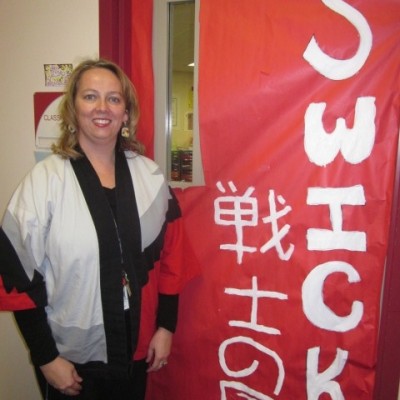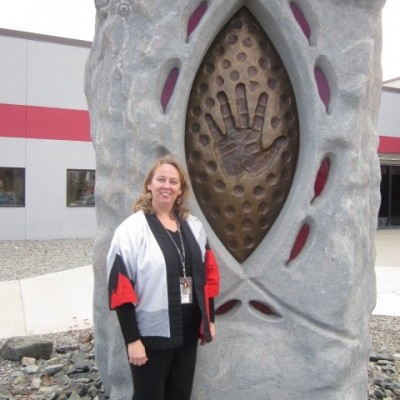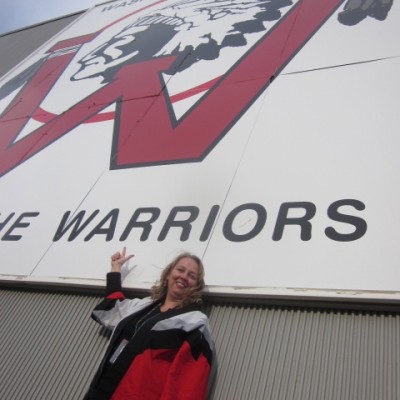“I promote excellence. I build relationships. I create connections. I foster friendship. I inspire life-long learning. I make a difference in our world.”
Carla Swick is a teacher at Wasilla High School. She attended the 2013 Talk Story, Write Story workshop in Anchorage.
WHY I TEACH
My first ambition was to be a waitress who sold postcards. Both my parents were born in Canada so we would often drive the Alcan to Gibbons, Alberta to visit relatives. We’d stop at a Eureka Roadhouse 85 miles north of Palmer for our first coffee break and a piece of pie. The postcards at the cashier’s desk appealed to my wanderlust and I thought as a waitress I’d always be able to talk with travelers. I was nine years old. In high school I decided I wanted to be an ambassador to another country. When I realized I needed to be appointed by the President of the United States, I knew I needed a backup plan.
I have always loved school. When I reminisce about my elementary school days, I remember loving the spelling tests, world fairs, Valentine’s Day boxes, four-square, and yes, homework too. I recall watching my older brother Robbie study at night and thinking, “I can’t wait until I get into high school and have real homework.” As a student, learning was fun and every day was different. As a teacher, that still holds true. I never get bored. Every class, every period, every day, and each student is different. I like the challenges that brings. I also love how I too can still be a student in my own classroom.
There are, however, some cons to the profession: Teaching is not a 9-5 job. The inbox is never empty. It seems like teachers are always being asked to do more with less. There is a higher expectation to collaborate, yet there isn’t any time built in the day to do it. When our school district changed form a six to seven period day, the shift was rough. It is mentally and physically exhausting to juggle five preps, keep up with planning, paperwork, and grading while attempting to be an excellent mother and wife. It is difficult to turn off school when I go home. I always feel the struggle of home life versus school from August through May. I hear the advice, “Lower your expectations,” but that will never be an option in my classroom.
The reality is I love teaching. This year during parent conferences, I had a Japanese 2 student bring in her mom and grandmother. She proudly showed them where she sat in class and explained how, as the “nichhoku” or head student, she helped set-up the room and start class. Opening up her Japanese notebook, she confidently explained the different writing systems of hiragana, katakana, and kanji used in her essay. I could feel her sense of pride and accomplishment. Learning did not come easily to this student. I knew she probably spent twice as long on each assignment in comparison to her classmates. Her grandmother told me she considered quitting Japanese after year one because it was challenging, but she learned that she could be successful and that built her confidence. Her love of Japanese was worth the effort.
I also love hands-on education and exposing my students to the world. Sixteen of my Japanese language students hosted sixteen students from Takefu Higashi High School for ten days prior to school starting. It was a summer exchange program that I created. I was surprised how the majority of my own students had not connected to their own community. Local legend and four-time Iditarod Champion Martin Buser’s shared his story and the world of mushing on a visit his Happy Trail Kennels. My students discovered the historical influence of gold and the railroad for the Valley as they hiked Independence Mine with volunteer Alaska State Park guides. They discussed theories to the decline of the Stellar sea lion population as they dissected scat at the Alaska SeaLife Center in Seward. And by the end of our long road trips, everyone had an appreciation for 80s music. I can still hear our Japanese brothers and sisters belting out the lyrics to Eye of the Tiger with their new Warrior family.
Being able to see my students use their English and Japanese to communicate and make real connections was priceless. I cherish their “aha” moments. One of my students, Gwen Swingle, shared in a reflection: “I learned not only about the Japanese Language and their rich culture but also about my community, and myself; probably more than I have in my 18 years of life. By trying to explain day-to-day things that I normally take for granted I learned how to express myself in more than words. I learned that everyone makes mistakes and that no matter what part of the world you grow up in, we really aren’t that different.”
It seems a bit morbid to say that I like to see my students cry, but it is a satisfying moment when I witness thirty students along with their families hugging each other, not wanting to leave after their ten days together. I rarely see this level of emotion in a classroom, but after ten days together, departure was a cry fest. This is evidence that despite the language barrier, my students have connected on a deep level and Japan will always be on their radar because now they have true Japanese friends.
Looking back at my twenty years in the classroom, I realize I did attain my original dream of becoming an ambassador. I may not work for the White House, but I do represent the teaching profession well. I promote excellence. I build relationships. I create connections. I foster friendship. I inspire life-long learning. I make a difference in our world.
LEADERSHIP
Letting Go
I can see snapshots of powerful moments. After two hours by jet airplane from Anchorage to Nome and then an hour in a nine-seater bush plane, we landed in Savoonga on St. Lawrence Island. Honestly, it felt like a National Geographic expedition. Located 150 miles west of mainlaind Alaska, Savoonga is one of the two Siberian-Yupik villages in Alaska. We arrived to learn that one of the elders, Rose, had just died and we would be gathering with the rest of the town for her funeral. This was not part of the planned itinerary and we didn’t really know what to say, how to act, or what to do. I simply told my students: “Observe and follow.”
After hours of speeches, hymns, and wailing all in Siberian Yupik, the mass of villagers moved from the school’s gymnasium outside to their snow machines and sleds. The coffin, built in the high school woodshop the day before, was lifted onto a sled attached to a snow machine. The procession was moving to the cemetery, a few miles from town. Without any idea of the custom or procedure, we just joined the crowd and were invited with the wave of a hand to pile onto the sleds. Arriving at the gravesite, we were met with the wailing of women, children, and men mixed with the Siberian-Yupik words of the minister which competed with the howl of the northern sea wind. Wreaths of plastic flowers covered the coffin which would remain above ground for months until the earth thawed. Looking past the Russian-Orthodox crosses, we could see the snow covered tundra roll for countless miles until it blended with the white-gray sky. In the realm of the Arctic, we felt truly insignificant, yet within this community of mourners we felt welcomed and honored to be a part of the memorial.
After returning to the village by snow machine, we headed back towards the school in our oversized parkas and clunky boots. We weren’t worried about fashion; we just wanted to stay warm. The heart of the village was Kingeekuk School surrounded by teaching housing, the post office, the community center/bingo hall and a few churches. The rest of the village buildings were family homes. A woman popped out her front door and asked, “You from Wasilla?” As the only visitors in town, we definitely stuck out. That was our invitation to come in for a cup of tea and some cookies. Orrie, my team teacher, always amazed me with her ability to get people to tell their life story. She had a magical and natural way of asking questions that I possibly wouldn’t even ask people I had been friends with for years. Orrie somehow naturally weaved it into her conversation within the first five minutes. She had a love for people and their history and every cup of tea in her presence was like an ancient storytelling circle. She would skip idle chat about the weather and get personal, not in a rude way but a real way. We all sat on the couch and around the kitchen table and asked the woman about life growing up in Savoonga and the changes over the years.
While the one store in town was convenient, over 80% of her family’s food still came from subsistence hunting– mainly walrus, whale, and seal– and gathering. With a gallon of fresh milk selling for $18 a gallon, it simply wasn’t financially feasible to feed a family from the store alone. She told us in the summer they would gather greens, berries, and bird eggs from the cliffs on the edge of town. The men would hunt for whale, seal, and walrus. It was a bountiful whaling season for the village that year; the spring hunting party had landed three bowhead whales.
Family photos adorned the living room wall, but my eyes were drawn to one photo in particular, an old black and white shot of a beautiful woman with tattoos along her cheeks and chin. We learned it was an old photograph of the woman’s grandmother. The reporter in me wanted to snap a few candid shots of our teatime and shoot a few video clips of our conversation. I didn’t want to be turned down, but I knew out of respect we needed to ask permission. “Do you mind if I take a few photos of you with our students?” I asked. She shook her head explaining, “No photos. Part of the soul is lost when an outsider takes our picture. That is why the photographer returned the photo of my grandmother.” On one hand, we were disappointed for the lost opportunity, yet we realized we had been given a real gift of connection that would forever be recorded in our collective memory.
Helping my five students bridge the cultural gap from urban Alaska to rural Alaska during our week-long exchange in Savoonga built mutual respect and understanding, and pushed us outside our comfort zones. The gift was self-awareness. We were all used to life being dictated by the bell at Wasilla High and there is a comfort in routine. 7:45 AM – 8:32 AM Period 1 (47 minutes). Ring — 6 minute passing period. Ring 8:38 AM – 9:24 AM Period 2 (46 minutes). Ring — 6 minute passing period. Ring 9:30 AM –10:16 AM Period 3 (46 minutes). Ring — 6 minute passing period. Ring 10:16 AM –10:46 AM Lunch A (30 minutes). Ring — 6 minute passing period. Ring 10:52 AM –11:39 AM Period 4 (47 minutes). Ring — 6 minute passing period. Ring 11:45 AM –12:31 AM Period 5 (46 minutes). Ring — 6 minute passing period. Ring 12:37 PM –1:23 PM Period 6 (46 minutes). Ring — 6 minute passing period. Ring 1:29 PM –2:15 PM Period 7 (46 minutes). Ring – the school day ends. In Savoonga, our five senses—not the bell—became our guide. We learned the power of observation and the freedom and growth that can come by letting go of expectations. We learned to just be.



